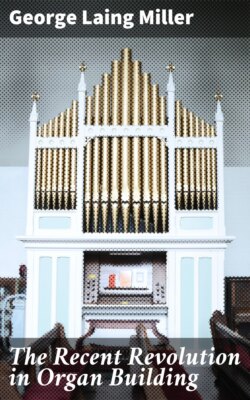Читать книгу The Recent Revolution in Organ Building - George Laing Miller - Страница 20
На сайте Литреса книга снята с продажи.
TUBULAR PNEUMATICS.[1]
ОглавлениеTable of Contents
In the year 1872 Henry Willis built an organ for St. Paul's Cathedral, London, which was divided in two portions, one on each side of the junction of the Choir with the Dome at an elevation of about thirty feet from the floor. The keyboards were placed inside one portion of the instrument, and instead of carrying trackers down and under the floor and up to the other side, as had hitherto been the custom in such cases, he made the connection by means of tubes like gaspipes, and made a pulse of wind travel down and across and up and into the pneumatic levers controlling the pipes and stops. Sir John Stainer describes it as "a triumph of mechanical skill." He was organist of St. Paul's for many years and ought to know. This was all very well for a cathedral, where
" … the long-drawn aisles
The melodious strains prolong"
but here is what the eminent English organist, W. T. Best, said about tubular pneumatic action as applied to another organ used for concert purposes: "It is a complete failure; you cannot play a triplet on the Trumpet, and I consider it the most d——nable invention ever placed inside an organ." Notwithstanding these drawbacks this action became very fashionable after its demonstration at St. Paul's, and was used even in small organs in preference to the Barker lever. One builder confessed to the writer that he had suffered severe financial loss through installing this action. After expending considerable time (and time is money) in getting it to work right, the whole thing would be upset when the sexton started up the heating apparatus. The writer is acquainted with organs in New York City where these same conditions prevail.
The writer, however, will admit having seen some tubular actions which were fairly satisfactory, one in particular in the factory of Alfred Monk, London, England, where for demonstration purposes the tubes were fifty feet long. Dr. Bédart informs us that Puget, the famous organ builder of Toulouse, France, sets fifty feet as the limit of usefulness of this action.
Henry Willis & Sons in their description of the organ in the Lady Chapel of Liverpool Cathedral state that their action has been tested to a repetition of 1,000 per minute, quicker than any human finger can move. This is a square organ in one case, but we note they have adopted the electric action for the great cathedral organ where the distance of the pipes from the keys is too great for satisfactory response.
In view of the wide use at present of this action we give a drawing and description of its operation as patented and made by Mr. J. J. Binns, of Bramley, Leeds, England. J. Matthews, in his "Handbook of the Organ," says that this action is very good and free from drawbacks.
